Multi-Scenario Response of Ecosystem Service Value in High-Groundwater-Level Coal–Grain Overlapping Areas Under Dual Objective Constraints
Abstract
1. Introduction
2. Study Area
3. Materials and Methods
3.1. Data Source
3.2. Methods
- (1)
- Propose key scientific questions: Focus on the impact of urbanization, agricultural protection, and other factors on ecosystem structure, function, and human well-being, clarify the need for quantitative evaluation, and find optimization paths.
- (2)
- Multi-scenarios design: Based on PIM and Markov model, combined with subsidence area management strategy and regional development strategy, considering land demand constraints such as ID and FS to construct scenarios.
- (3)
- Predicting future land use: Using the PLUS model, conducting random forest and expansion potential analysis, and based on data from 2010 to 2020, simulate the spatial allocation of land use patches.
- (4)
- Comparative analysis of ESV in multi-scenarios: Quantify ESV in different scenarios, conduct functional and spatial synergy analysis, seek Pareto improvement, and support sustainable development.
3.2.1. PIM: Probability Integral Method
3.2.2. PLUS Model
- (5)
- Selection of driving factors
- (6)
- Multi-scenario rule formulation with dual objective constraints
3.2.3. ESV Calculation
4. Results
4.1. Prediction of Coal Mining Subsidence Level and Spatial Distribution
4.2. Land Use Simulation Under Different Development Scenarios
4.3. ESV Calculation Results and Comparative Analysis
5. Discussion
5.1. The Necessity of Imposing Dual Constraints on Land Use Demand in Coal–Grain Overlapping Areas—Differences in Ecosystem Evolution Paths
5.2. Coal–Grain Overlapping Areas’ ESV Evolution Characteristics and Governance Path Trade-Offs Under Different Scenarios
6. Limitations
7. Conclusions
Author Contributions
Funding
Institutional Review Board Statement
Informed Consent Statement
Data Availability Statement
Acknowledgments
Conflicts of Interest
References
- Costanza, R.; D’Arge, R.; de Groot, R.; Farber, S.; Grasso, M.; Hannon, B.; Limburg, K.; Naeem, S.; O’Neill, R.V.; Paruelo, J.; et al. The value of the world’s ecosystem services and natural capital. Nature 1997, 387, 253–260. [Google Scholar] [CrossRef]
- Daily, G.C. Nature’s services: Societal dependence on natural ecosystems. Pac. Conserv. Biol. 1997, 6, 220–221. [Google Scholar]
- De Groot, R.S.; Wilson, M.A.; Boumans, R.M.J. A typology for the classification, description and valuation of ecosystem functions, goods and services. Ecol. Econ. 2002, 41, 393–408. [Google Scholar] [CrossRef]
- Tallis, H.; Mooney, H.; Andelman, S.; Balvanera, P.; Cramer, W.; Karp, D.; Polasky, S.; Reyers, B.; Ricketts, T.; Running, S.; et al. A global system for monitoring ecosystem service change. BioScience 2012, 62, 977–986. [Google Scholar] [CrossRef]
- MA (Millennium Ecosystem Assessment). Ecosystems and Human Well-being: Current State and Trends: Synthesis; Island Press: Washington, DC, USA, 2005; pp. 829–838. [Google Scholar]
- Bennett, E.M.; Peterson, G.D.; Levitt, E.A. Looking to the future ecosystem services. Ecosystems 2005, 8, 125–132. [Google Scholar] [CrossRef]
- Xie, G.D.; Lu, C.X.; Leng, Y.F. Valuation of Ecological Assets in the Qinghai Tibet Plateau. J. Nat. Resour. 2003, 18, 189–196. [Google Scholar]
- Su, Y.; Ma, X.; Feng, Q.; Liu, W.; Zhu, M.; Niu, J.; Liu, G.; Shi, L. Patterns and controls of ecosystem service values under different land-use change scenarios in a mining-dominated basin of northern China. Ecol. Indic. 2023, 151, 15. [Google Scholar] [CrossRef]
- Fisher, B.; Turner, R.K. Ecosystem services: Classification for valuation. Biol. Conserv. 2008, 141, 1167–1169. [Google Scholar] [CrossRef]
- Costanza, R.; de Groot, R.; Sutton, P.; van der Ploeg, S.; Anderson, S.J.; Kubiszewski, I.; Farber, S.; Turner, R.K. Changes in the global value of ecosystem services. Global Environ. Change 2014, 26, 152–158. [Google Scholar]
- Long, H.X.; Yuan, L.; Yin, Z.L.; Wu, X. Spatiotemporal of ecosystem service values response to land use/cover change based on geo-informatic Tupu-A case study in Tianjin. China. Ecol. Indic. 2023, 154, 110511. [Google Scholar] [CrossRef]
- Styers, D.M.; Chappelka, A.H.; Marzen, L.J.; Somers, G.L. Developing a land-cover classification to select indicators of forest ecosystem health in a rapidly urbanizing landscape. Landsc. Urban Plan. 2010, 94, 158–165. [Google Scholar] [CrossRef]
- Song, Y.; Zhang, M.; Sun, R. Using a new aggregated indicator to evaluate China’s energy security. Energy Policy 2019, 132, 167–174. [Google Scholar] [CrossRef]
- Xue, L.; Zhang, W.; Zheng, Z.; Liu, Z.; Meng, S.; Li, H.; Du, Y. Measurement and influential factors of the efficiency of coal resources of China’s provinces: Based on Bootstrap-DEA and Tobit. Energy 2021, 221, 119763. [Google Scholar] [CrossRef]
- Han, J.; Hu, Z.; Wang, P.; Yan, Z.; Li, G.; Zhang, Y.; Zhou, T. Spatio-temporal evolution and optimization analysis of ecosystem service value-A case study of coal resource-based city group in Shandong, China. J. Clean. Prod. 2022, 363, 132602. [Google Scholar] [CrossRef]
- Xiao, W.; Fu, Y.H.; Wang, T.; Lv, X.J. Effects of land use transitions due to underground coal mining on ecosystem services in high groundwater table areas: A case study in the Yanzhou coalfield—ScienceDirect. Land Use Policy 2018, 71, 213–221. [Google Scholar] [CrossRef]
- Zhu, X.; Ning, Z.; Cheng, H.; Zhang, P.; Sun, R.; Yang, X.; Liu, H. A novel calculation method of subsidence waterlogging spatial information based on remote sensing techniques and surface subsidence prediction. J. Clean. Prod. 2022, 335, 130366. [Google Scholar] [CrossRef]
- Hu, Z.Q.; Li, J.; Zhao, Y.L. Problems, Causes, and Countermeasures of Environmental Quality and Food Security in Mineral and Grain Composite Main Production Areas. Sci. Technol. Rev. 2006, 24, 21–24. [Google Scholar]
- He, T.; Xiao, W.; Zhao, Y.L.; Deng, X.; Hu, Z. Identification of waterlogging in Eastern China induced by mining subsidence: A case study of Google Earth Engine time-series analysis applied to the Huainan coal field. Remote Sens. Environ. 2020, 242, 111742. [Google Scholar] [CrossRef]
- Bian, Z.; Miao, X.; Lei, S.; Chen, S.; Wang, W.; Struthers, S. The challenges of reusing mining and mineral-processing wastes. Science 2012, 337, 702–703. [Google Scholar] [CrossRef]
- Darwin, R.; Tsigas, M.; Lewandrowski, J.; Raneses, A. Land use and cover in ecological economics. Ecol. Econ. 1996, 17, 157–181. [Google Scholar] [CrossRef]
- Xiao, J.; Zhang, Y.; Xu, H. Response of ecosystem service values to land use change, 2002–2021. Ecol. Indic. 2024, 160, 111947. [Google Scholar] [CrossRef]
- Wang, J.; Peng, P.; Liu, T.; Wang, J.; Zhang, S.; Niu, P. Revealing the Spatiotemporal Changes in Land Use and Landscape Patterns and Their Effects on Ecosystem Services: A Case Study in the Western Sichuan Urban Agglomeration, China. Land 2025, 14, 1012. [Google Scholar] [CrossRef]
- Fu, B.J.; Zhang, L.W. Land use change and ecosystem services: Concepts, methods, and progress. Adv. Geogr. Sci. 2014, 33, 441–446. [Google Scholar]
- Han, J.; Hu, Z.; Mao, Z.; Li, G.; Liu, S.; Yuan, D.; Guo, J. How to Account for Changes in Carbon Storage from Coal Mining and Reclamation in Eastern China? Taking Yanzhou Coalfield as an Example to Simulate and Estimate. Remote Sens. 2022, 14, 2014. [Google Scholar] [CrossRef]
- Zhang, M.; Yuan, X.; Guan, D.; Liu, H.; Sun, K.; Zhang, G.; Wang, K.; Zhou, L.; Wang, F.; Sun, J. An ecological scenario prediction model for newly created wetlands caused by coal mine subsidence in the Yanzhou, China. Environ. Geochem. Health 2020, 42, 1991–2005. [Google Scholar] [CrossRef]
- Liu, S.; Liu, L.; Li, J.; Zhou, Q.; Ji, Y.; Lai, W.; Long, C. Spatiotemporal Variability of Human Disturbance Impacts on Ecosystem Services in Mining Areas. Sustainability 2022, 14, 7547. [Google Scholar] [CrossRef]
- Bao, X.Y.; Guo, Q.B.; Wu, S.B.; Luo, J.; Xu, J.R. Identifying the spatio-temporal evolution and driving mechanisms of ecosystem service value in high groundwater table coal mining areas. Environ. Monit. Assess. 2025, 197, 581. [Google Scholar] [CrossRef] [PubMed]
- Kouassi, J.L.; Gyau, A.; Diby, L.; Bene, Y.; Kouamé, C. Assessing land use and land cover change and farmers’ perceptions of deforestation and land degradation in South-West Côte d’Ivoire, West Africa. Land 2021, 10, 429. [Google Scholar] [CrossRef]
- Haase, D.; Haase, A.; Kabisch, N.; Kabisch, S.; Rink, D. Actors and factors in land-use simulation: The challenge of urban shrinkage. Environ. Model. Softw. 2012, 35, 92–103. [Google Scholar] [CrossRef]
- Li, X.; Li, X. and Yeh, A.G.-O. Neural-Network-Based Cellular Automata for Simulating Multiple Land Use Changes Using GIS. Int. J. Geogr. Inf. Sci. 2002, 16, 323–343. [Google Scholar] [CrossRef]
- Li, S.Y.; Liu, X.P.; Li, X.; Chen, Y.M. Research progress on simulation models and applications of land use change. J. Remote Sens. 2017, 21, 329–340. [Google Scholar]
- Yang, J.; Gong, J.; Tang, W.; Liu, C. Patch-based cellular automata model of urban growth simulation: Integrating feedback between quantitative composition and spatial configuration. Comput. Environ. Urban Syst. 2020, 79, 101402. [Google Scholar] [CrossRef]
- Sohl, T.L.; Claggett, P.R. Clarity versus complexity: Land-use modeling as a practical tool for decision-makers. J. Environ. Manag. 2013, 129, 235–243. [Google Scholar] [CrossRef] [PubMed]
- Li, G.; Cheng, G.; Liu, G.; Chen, C.; He, Y. Simulating the land use and carbon storage for nature-based solutions (nbs) under multi-scenarios in the three gorges reservoir area: Integration of remote sensing data and the rf-markov-ca-invest model. Remote Sens. 2023, 15, 24. [Google Scholar] [CrossRef]
- Nasiakou, S.; Vrahnakis, M.; Chouvardas, D.; Mamanis, G.; Kleftoyanni, V. Land use changes for investments in silvoarable agriculture projected by the clue-s spatio-temporal model. Land 2022, 11, 598. [Google Scholar] [CrossRef]
- Li, Z.; Wu, S.L.; Zhang, S.W.; Nie, C.; Li, Y.; Huang, Y. Optimization of Land Reuse Structure in Coal Mining Subsided Areas Considering Regional Economic Development: A Case Study in Pei County, China. Sustainability 2020, 12, 3335. [Google Scholar] [CrossRef]
- Zhu, K.; Cheng, Y.; Zang, W.; Zhou, Q.; El Archi, Y.; Mousazadeh, H.; Kabil, M.; Csobán, K.; Dávid, L.D. Multiscenario Simulation of Land-Use Change in Hubei Province, China Based on the Markov-FLUS Model. Land 2023, 12, 744. [Google Scholar] [CrossRef]
- Liang, X.; Guan, Q.; Clarke, K.C.; Liu, S.; Wang, B.; Yao, Y. Understanding the drivers of sustainable land expansion using a patch-generating simulation (PLUS) model: A case study in Wuhan, China. Comput. Environ. Urban Syst. 2021, 85, 101569. [Google Scholar] [CrossRef]
- Liu, X.; Liang, X.; Li, X.; Xu, X.; Ou, J.; Chen, Y.; Li, S.; Wang, S.; Pei, F. A future land use simulation model (FLUS) for simulating multiple land use scenarios by coupling human and natural effects. Landsc. Urban Plan. 2017, 168, 94–116. [Google Scholar] [CrossRef]
- Jiang, X.F.; Duan, H.C.; Liao, J.; Song, X.; Xue, X. Research on Land Use in the Ganlin Plateau of the Middle Reaches of the Heihe River Basin Based on the PLUS-SD Coupling Model. Arid. Reg. Res. 2022, 39, 1246–1258. [Google Scholar]
- Yu, Z.; Zhao, M.; Gao, Y.; Wang, T.; Zhao, Z.; Wang, S. Multiscenario Simulation and Prediction of Land Use in Huaibei City Based on CLUE-S and PLUS Models. Appl. Sci. 2023, 13, 7142. [Google Scholar] [CrossRef]
- Yingchun, L.; Yande, J.; Shanmei, H. Ecological function zoning of Nansi Lake Basin in China based on ecosystem service bundles. Environ. Sci. Pollut. Res. 2023, 30, 77343–77357. [Google Scholar] [CrossRef]
- Chi, S.; Wang, L.; Yu, X. A New Method for Calculating Prediction Parameters of Surface Deformation in the Mining Area. Appl. Sci. 2023, 13, 8030. [Google Scholar] [CrossRef]
- Deng, K.Z.; Zhang, D.Z.; Zhang, Z.Q. Discussion on prediction and control of surface subsidence under deep mining conditions. J. China Univ. Min. Technol. 2000, 1, 52–55. [Google Scholar]
- Aburas, M.M.; Ahamad, M.S.S.; Omar, N.Q. Spatio-temporal simulation and prediction of land-use change using conventional and machine learning models: A review. Environ. Monit. Assess. 2019, 191, 205. [Google Scholar] [CrossRef] [PubMed]
- Chughtai, A.H.; Abbasi, H.; Ismail, R.K. A review on change detection method and accuracy assessment for land use land cover. Remote Sens. Appl. Soc. Environ. 2021, 22, 100482. [Google Scholar] [CrossRef]
- Xie, G.D.; Zhang, C.X.; Zhang, L.M.; Chen, W.; Li, S. Improvement of ecosystem service valuation method based on unit area value equivalent factor. Chin. J. Nat. Resour. 2015, 30, 1243–1254. [Google Scholar]
- Gong, J.; Liu, D.Q.; Zhang, J.X.; Xie, Y.C.; Cao, E.J.; Li, H.Y. Tradeofs/synergies of multiple ecosystem services based on land use simulation in a mountain-basin area, western China. Ecol. Indic. 2019, 99, 283–293. [Google Scholar] [CrossRef]
- Qian, X.S. A New Scientific Field—Open Complex Giant Systems and Their Methodology. Urban Dev. Res. 2005, 13, 3–10. [Google Scholar]
- Holt, A. Understanding environmental and geographical complexities through similarity matching. Complex. Int. 2000, 7, 1–16. [Google Scholar]
- Li, W.; Cai, Z.; Jin, L. Urban green land use efficiency of resource-based cities in China: Multidimensional measurements, spatial-temporal changes, and driving factors. Sustain. Cities Soc. 2024, 104, 105299. [Google Scholar] [CrossRef]
- Du, L.; Hou, Y.; Zhong, S.; Qu, K. Identification of Priority Areas for Ecological Restoration in Coal Mining Areas with a High Groundwater Table Based on Ecological Security Pattern and Ecological Vulnerability. Sustainability 2024, 16, 159. [Google Scholar] [CrossRef]
- Chen, S.; Qin, J.; Dong, S.; Liu, Y.; Sun, P.; Yao, D.; Song, X.; Li, C. Assessing the Impact of Land Use Changes on Ecosystem Service Values in Coal Mining Regions Using Google Earth Engine Classification. Remote Sens. 2025, 17, 1139. [Google Scholar] [CrossRef]
- Dong, J.H.; Dai, W.T.; Xu, J.R.; Zhang, H.; Li, Y.P.; Xie, F. Impact and elastic modulus of coal mining on terrestrial ecosystems. Sci. Rep. 2025, 15, 9454. [Google Scholar] [CrossRef]
- Zhao, J.G.; Song, S.; Zhang, K.; Li, X.N.; Zheng, X.H.; Wang, Y.; Ku, G. An investigation into the disturbance efects of coal mining on groundwater and surface ecosystems. Environ. Geochem. Health 2023, 45, 7011–7031. [Google Scholar] [CrossRef]
- Chen, Y.; Yu, X.; Xu, D.; Peng, J. A spatial machine learning approach to exploring the impacts of coal mining and ecological restoration on regional ecosystem health. Environ. Res. 2024, 264, 120379. [Google Scholar] [CrossRef]
- Gao, F.; Xin, X.; Song, J.; Li, X.; Zhang, L.; Zhang, Y.; Liu, J. Simulation of LUCC Dynamics and Estimation of Carbon Stock under Different SSP-RCP Scenarios in Heilongjiang Province. Land 2023, 12, 1665. [Google Scholar] [CrossRef]
- Fan, F.F.; Xiao, C.W.; Feng, Z.M.; Chen, Y. Land-planning management based on multiple ecosystem services and simulation in tropical forests. J. Environ. Manag. 2022, 323, 116216. [Google Scholar] [CrossRef]
- Li, Y.; Han, X.; Zhou, B.; Lv, L.; Fan, Y. Farmland Dynamics and Its Grain Production Efficiency and Ecological Security in China’s Major Grain-Producing Regions between 2000 and 2020. Land 2023, 12, 1404. [Google Scholar] [CrossRef]
- Zhou, S.Y.; Chang, J.; Luo, P.J. Landscape dynamics and human disturbance processes in wetlands in a mining city: A case study in Huaibei, China. Environ. Monit. Assess. 2025, 197, 581. [Google Scholar] [CrossRef]
- Li, W.J.; Guo, J.Y.; Tang, Y.H.; Zhang, P.C. Resilience of agricultural development in China’s major grain-producing areas under the double security goals of “grain ecology”. Environ. Sci. Pollut. Res. 2024, 31, 5881–5895. [Google Scholar] [CrossRef]
- Xu, J.; Yin, P.; Hu, W.; Fu, L.; Zhao, H.; Xue, B. Assessing the ecological regime and spatial spillover effects of a reclaimed mining subsided lake: A case study of the Pan’an Lake wetland in Xuzhou. PLoS ONE 2020, 15, e0238243. [Google Scholar] [CrossRef]
- Zhao, Q.; Niu, K. Blessings or curses?—The bittersweet impacts of the mining industry on rural livelihoods in China. J. Clean. Prod. 2023, 421, 138548. [Google Scholar] [CrossRef]
- Wang, P.; Wang, J.; Zhu, C.; Li, Y.; Sun, W.; Li, J. Factors Influencing Livelihood Resilience of Households Resettled from Coal Mining Areas and Their Measurement-A Case Study of Huaibei City. Land 2024, 13, 13. [Google Scholar] [CrossRef]
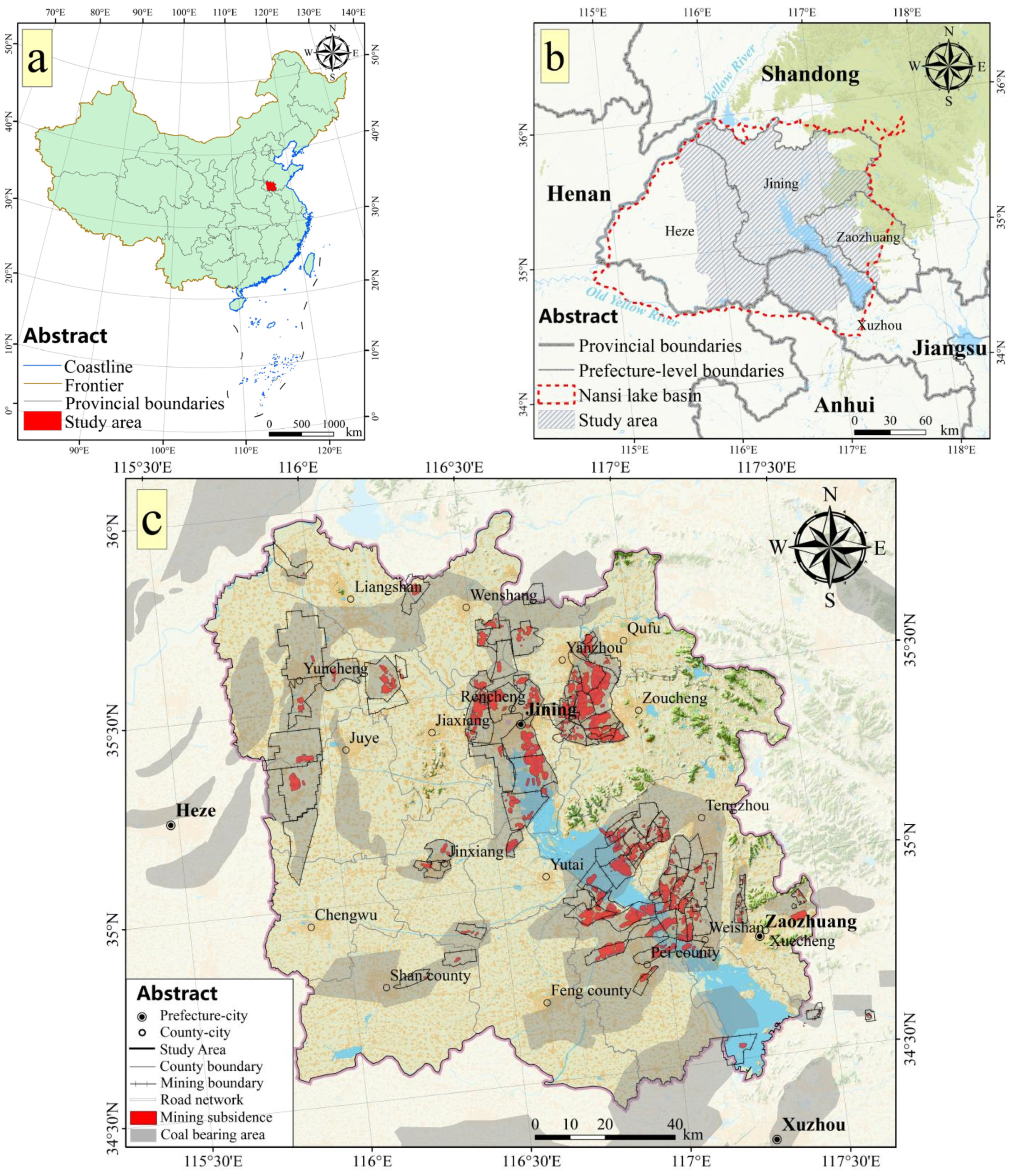
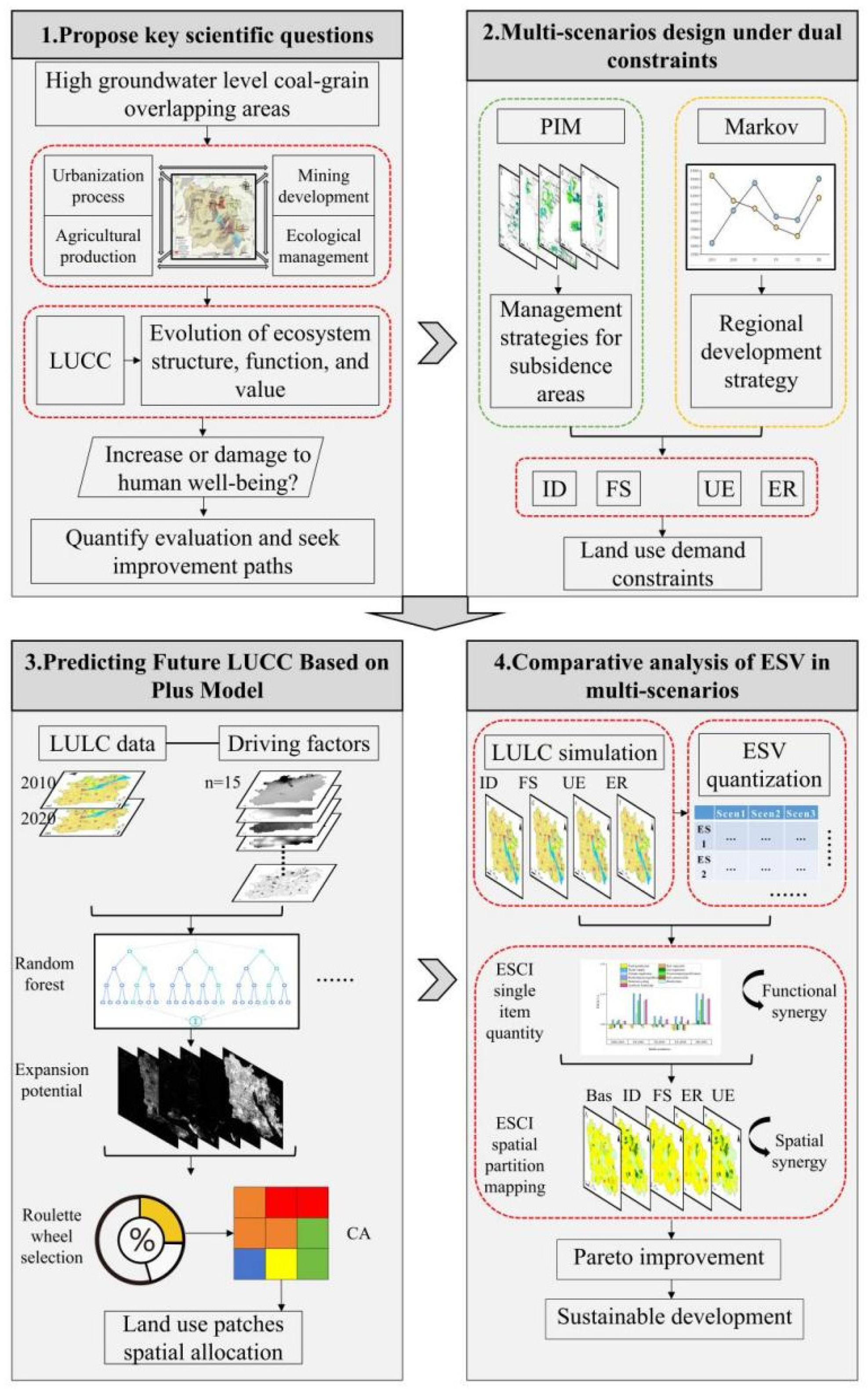
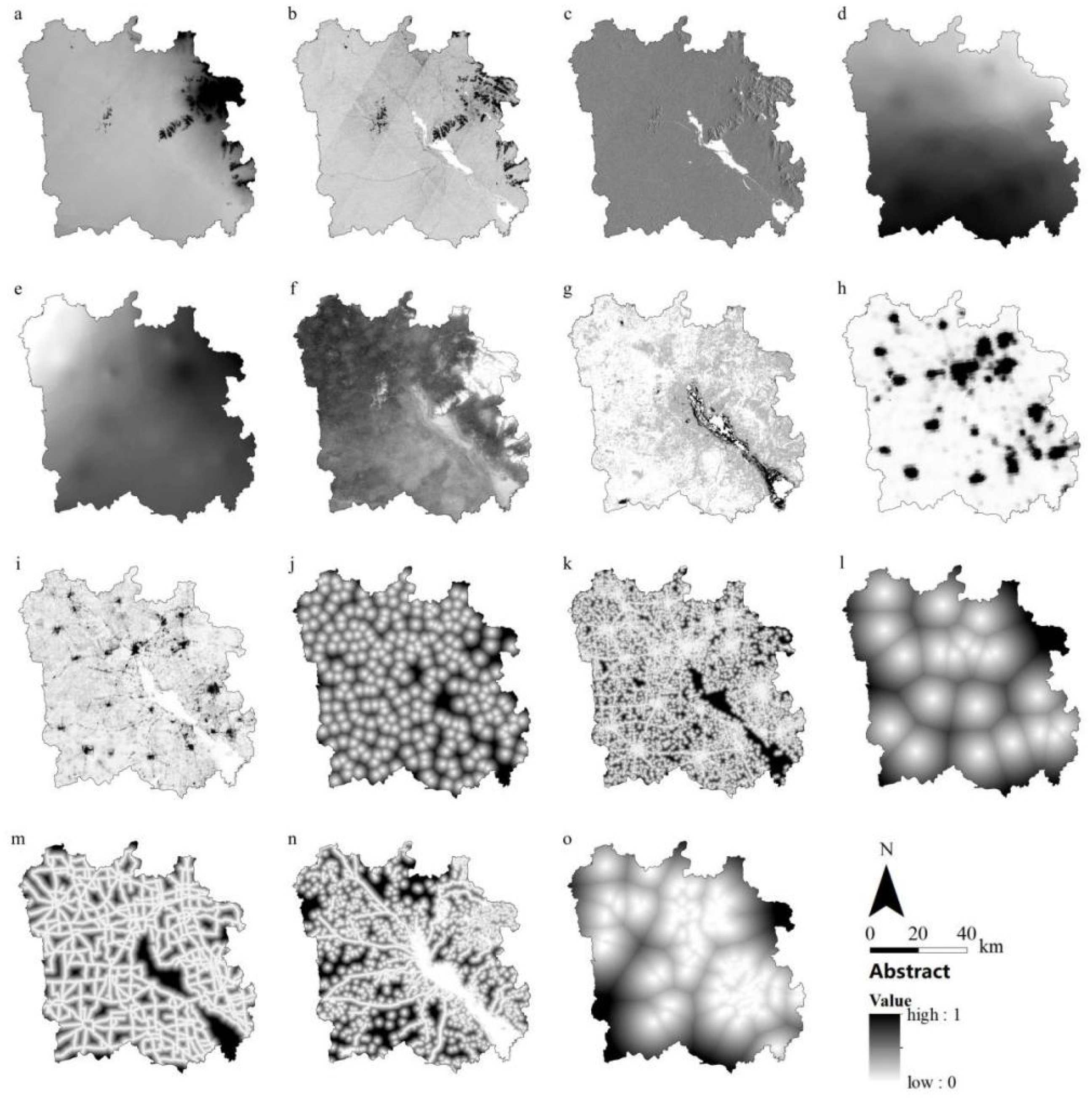

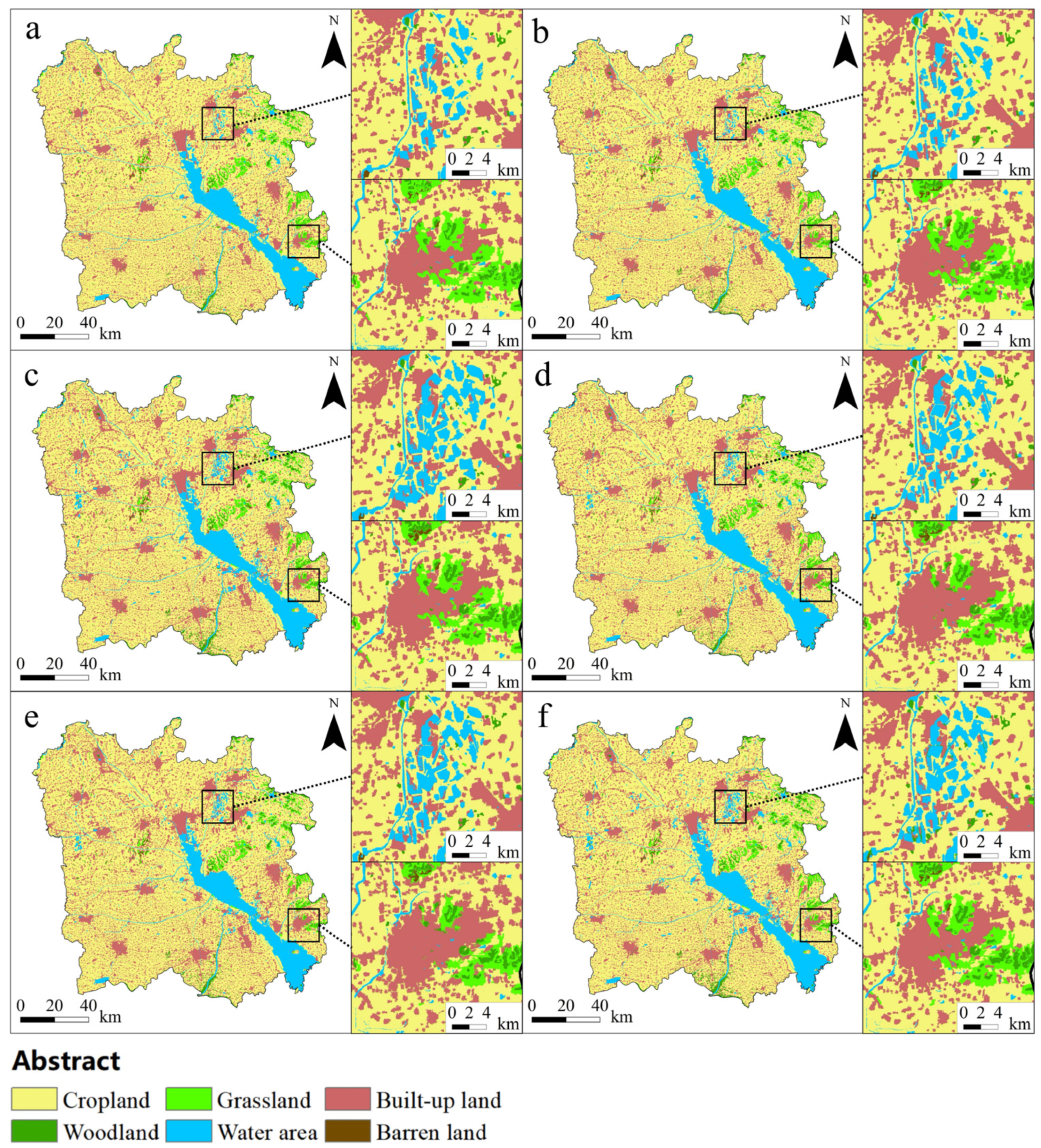
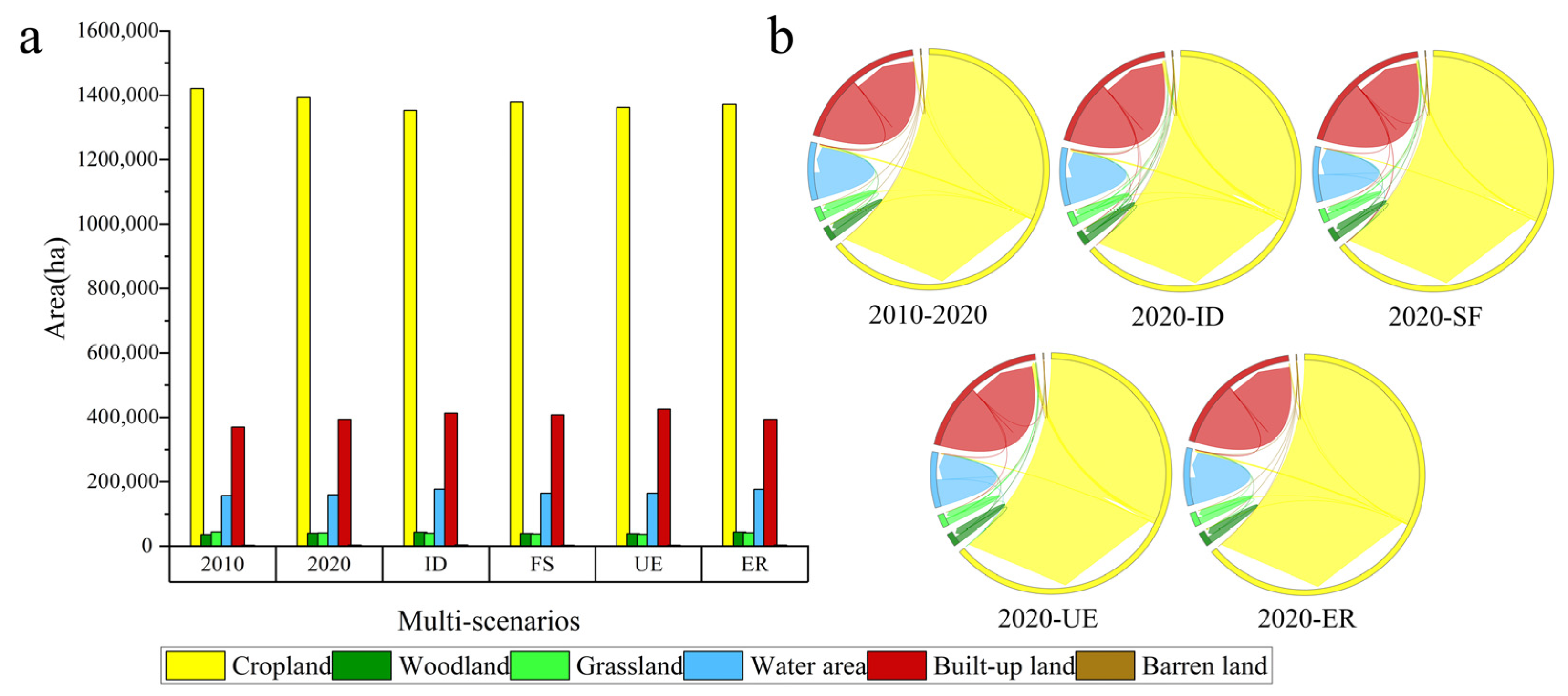
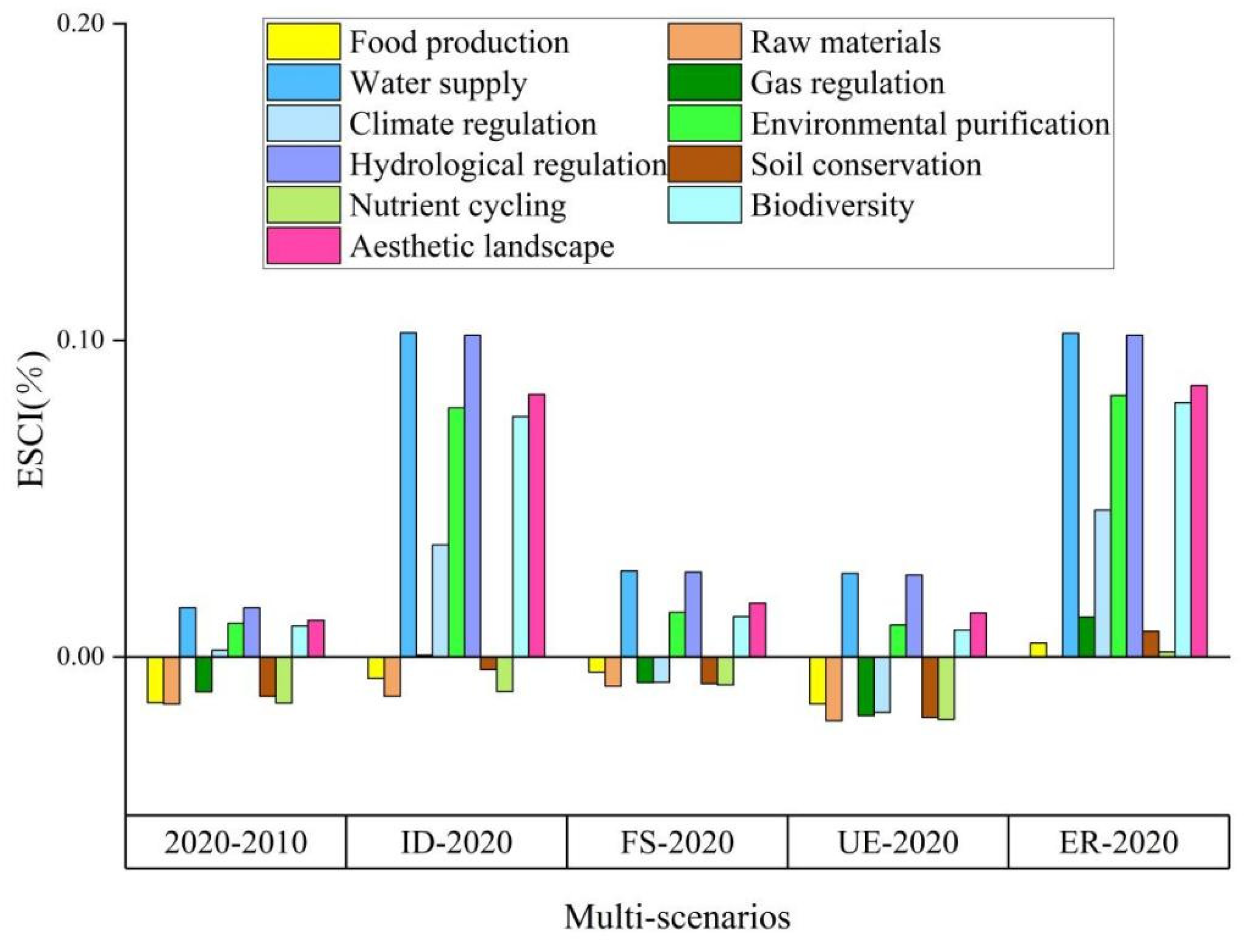
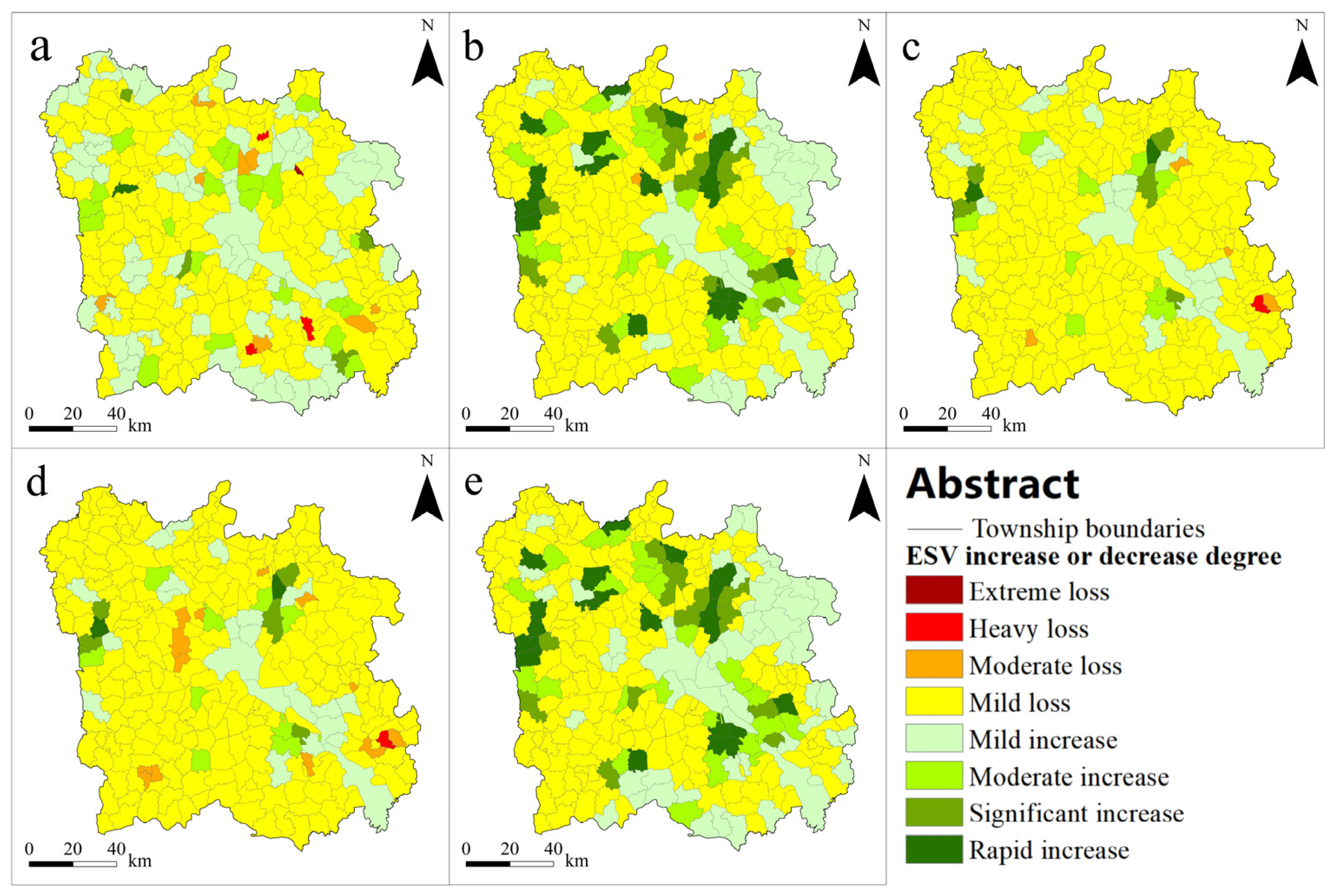
| Data Type | Data Content | Data Year | Data Accuracy | Data Source |
|---|---|---|---|---|
| Land use data | Primary classification | 2010, 2020 | 30 m | CNLUCC (https://www.resdc.cn/Default.aspx, accessed on 22 September 2024) |
| Basic geographic data | DEM | 2019 | 12.5 m | ALOS (https://search.asf.alaska.edu/, accessed on 14 November 2022) |
| Soil data | 2019 | 250 m | Predictive Soil Mapping with R. (https://opengeohub.org/, accessed on 6 January 2025) | |
| Meteorological data | 1980–2020 | - | National Meteorological Science Data Center (http://data.cma.cn/, accessed on accessed on 6 January 2025) | |
| Socio-economic data | GDP, population | 2020 | 130 m, 100 m | Luojia-1 (http://www.hbeos.org.cn/, accessed on 18 February 2025) PoPSE (https://doi.org/10.6084/m9.figshare.24916140.v1, accessed on 15 February 2025) |
| Road network data | 2023 | - | Open Street Map (https://www.openstreetmap.org/, accessed on 18 December 2023) | |
| POI | 2024 | - | Gaode Map Open Platform API (https://lbs.amap.com/, accessed on 29 December 2024) | |
| Constraint data | Coalfield geological data | 2018 | - | The First Exploration Team of Shandong Coalfield Geologic Bureau |
| Ecological Red Line Boundary of Nansihu District | 2020 | 1:1,000,000 | Official website of Shandong Provincial Department of Ecology and Environment (http://xxgk.sdein.gov.cn/xxgkml/hbxlcj/, accessed on 3 September 2023) |
| Scenario Type | Core Objectives | Dual Constraint Rules | |
|---|---|---|---|
| Outside the Subsidence Area | Within the Subsidence Area | ||
| ID | Continuing the existing development model, balancing economy and ecology | The areas of cropland and grassland continue to decrease, while the areas of forest land, water bodies, and built-up land continue to expand. Except for water bodies that cannot be converted into other land types, other land types can be converted into each other. | The subsidence zone allows for natural evolution. Mild subsidence areas generally do not produce water accumulation, but built-up land will no longer increase. The land types in moderate and severe subsidence areas have been converted to water bodies. |
| FS | Protecting basic cropland, controlling land non-agriculturalization and promoting land reclamation | The probability of cropland being converted to other land types decreases by 20%, while the probability of woodland, grassland, and barren land being converted to cropland increases by 20%. | The original cropland in the mild subsidence area will no longer be converted to other land types. All areas with moderate subsidence, except for the lake area, will be reclaimed as cropland. Severe subsidence only transforms into water bodies, the same below. |
| UE | Promote industrialization and urbanization, prioritize the expansion of built-up land | The probability of converting other land types into built-up land increases by 30%. Except for restricted conversion areas and water bodies, all other land types can be converted into built-up land. | The built-up land in areas with mild subsidence is still expanding according to inertia. The built-up land in the moderately subsidence area, except for the lake area, will be restored to its original appearance after damage, while the rest of the land types will be reclaimed as cropland. |
| ER | Strictly adhere to the ecological red line, and promote ecological restoration projects | The conversion of forests and grasslands to other land types is restricted, and the probability of woodland land conversion to land types other than water area increases by 10%. | The probability of mild subsidence areas transforming into woodland and grassland increases by 10%. Except for the lake area, areas with moderate subsidence will restore their original woodland and grassland, while other land types will be converted into water bodies. |
| ES Functions | Crop | Wood | Grass | Water | Built | Barren | |
|---|---|---|---|---|---|---|---|
| Provision services | Food production | 0.85 | 0.24 | 0.38 | 1.35 | 0.00 | 0.00 |
| Raw materials | 0.40 | 0.55 | 0.56 | 0.37 | 0.00 | 0.00 | |
| Water supply | 0.02 | 0.28 | 0.31 | 5.44 | 0.00 | 0.00 | |
| Regulation services | Gas regulation | 0.67 | 1.79 | 1.97 | 1.34 | 0.00 | 0.02 |
| Climate regulation | 0.36 | 5.37 | 5.21 | 2.95 | 0.00 | 0.00 | |
| Environmental purification | 0.10 | 1.60 | 1.72 | 4.58 | 0.00 | 0.10 | |
| Hydrological regulation | 0.27 | 4.05 | 3.82 | 63.24 | 0.00 | 0.03 | |
| Support services | Soil conservation | 1.03 | 2.19 | 2.40 | 1.62 | 0.00 | 0.02 |
| Nutrient cycling | 0.12 | 0.17 | 0.18 | 0.13 | 0.00 | 0.00 | |
| Biodiversity | 0.13 | 2.00 | 2.18 | 5.21 | 0.00 | 0.02 | |
| Cultural services | Aesthetic landscape | 0.06 | 0.88 | 0.96 | 3.31 | 0.01 | 0.01 |
| Total | - | 4.01 | 19.12 | 19.69 | 89.54 | 0.01 | 0.20 |
| 2010 | 2020 | ID | FS | UE | ER | |
|---|---|---|---|---|---|---|
| Food production | 3.22 | 3.17 | 3.15 | 3.15 | 3.12 | 3.18 |
| Raw materials | 1.49 | 1.47 | 1.45 | 1.46 | 1.44 | 1.47 |
| Water supply | 2.02 | 2.05 | 2.26 | 2.11 | 2.11 | 2.26 |
| Gas regulation | 2.92 | 2.89 | 2.89 | 2.87 | 2.84 | 2.93 |
| Climate regulation | 3.12 | 3.12 | 3.23 | 3.10 | 3.07 | 3.27 |
| Environmental purification | 2.22 | 2.24 | 2.42 | 2.27 | 2.26 | 2.43 |
| Hydrological regulation | 23.68 | 24.05 | 26.49 | 24.69 | 24.67 | 26.49 |
| Soil conservation | 4.24 | 4.18 | 4.17 | 4.15 | 4.10 | 4.22 |
| Nutrient cycling | 0.45 | 0.45 | 0.44 | 0.44 | 0.44 | 0.45 |
| Biodiversity | 2.61 | 2.64 | 2.84 | 2.67 | 2.66 | 2.85 |
| Aesthetic landscape | 1.52 | 1.54 | 1.67 | 1.57 | 1.56 | 1.67 |
| Total | 47.49 | 47.80 | 51.01 | 48.48 | 48.27 | 51.21 |
Disclaimer/Publisher’s Note: The statements, opinions and data contained in all publications are solely those of the individual author(s) and contributor(s) and not of MDPI and/or the editor(s). MDPI and/or the editor(s) disclaim responsibility for any injury to people or property resulting from any ideas, methods, instructions or products referred to in the content. |
© 2025 by the authors. Licensee MDPI, Basel, Switzerland. This article is an open access article distributed under the terms and conditions of the Creative Commons Attribution (CC BY) license (https://creativecommons.org/licenses/by/4.0/).
Share and Cite
Niu, Q.; Zhu, D.; Wang, Y.; Ding, Z.; Qiu, G. Multi-Scenario Response of Ecosystem Service Value in High-Groundwater-Level Coal–Grain Overlapping Areas Under Dual Objective Constraints. Appl. Sci. 2025, 15, 9172. https://doi.org/10.3390/app15169172
Niu Q, Zhu D, Wang Y, Ding Z, Qiu G. Multi-Scenario Response of Ecosystem Service Value in High-Groundwater-Level Coal–Grain Overlapping Areas Under Dual Objective Constraints. Applied Sciences. 2025; 15(16):9172. https://doi.org/10.3390/app15169172
Chicago/Turabian StyleNiu, Qian, Di Zhu, Yinghong Wang, Zhongyi Ding, and Guoqiang Qiu. 2025. "Multi-Scenario Response of Ecosystem Service Value in High-Groundwater-Level Coal–Grain Overlapping Areas Under Dual Objective Constraints" Applied Sciences 15, no. 16: 9172. https://doi.org/10.3390/app15169172
APA StyleNiu, Q., Zhu, D., Wang, Y., Ding, Z., & Qiu, G. (2025). Multi-Scenario Response of Ecosystem Service Value in High-Groundwater-Level Coal–Grain Overlapping Areas Under Dual Objective Constraints. Applied Sciences, 15(16), 9172. https://doi.org/10.3390/app15169172






